Montserrat
Montserrat (/ˌmɒntsəˈræt/ MONT-sə-RAT) is a British Overseas Territory (BOT) in the Caribbean. The island is in the Leeward Islands, which is part of the chain known as the Lesser Antilles, in the West Indies. Montserrat measures approximately 16 km (10 mi) in length and 11 km (7 mi) in width, with approximately 40 km (25 mi) of coastline.[3] Montserrat is nicknamed "The Emerald Isle of the Caribbean" both for its resemblance to coastal Ireland and for the Irish ancestry of many of its inhabitants.[4][5]
Montserrat | |
|---|---|
 Flag 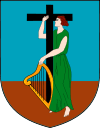 Coat of arms | |
| Motto(s): "A people of excellence, moulded by nature, nurtured by God" | |
| Anthem: "God Save the Queen" | |
| National song: "Motherland" | |
 Location of Montserrat (circled in red) | |
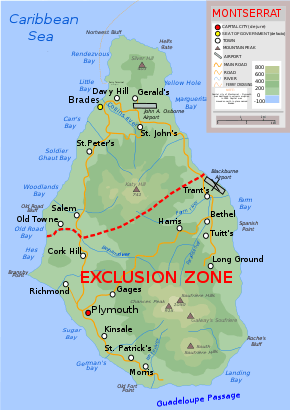 Topographic map of Montserrat showing the "exclusion zone" due to volcanic activity, and the new airport in the north. The roads and settlements in the exclusion zone have mostly been destroyed. | |
| Sovereign state | United Kingdom |
| English settlement | 1632 |
| Treaty of Paris | 3 September 1783 |
| Federation | 3 January 1958 |
| Separate colony | 31 May 1962 |
| Capital | Plymouth (de jure)[lower-alpha 1] Brades (de facto)[lower-alpha 2] Little Bay (under construction)[lower-alpha 3] 16°45′N 62°12′W |
| Largest city | Brades |
| Official languages | English |
| Demonym(s) | Montserratian |
| Government | Parliamentary dependency under a constitutional monarchy |
• Monarch | Elizabeth II |
• Governor | Andrew Pearce |
• Premier | Easton Taylor-Farrell |
| Tariq Ahmad | |
| Legislature | Legislative Assembly |
| Area | |
• Total | 102 km2 (39 sq mi) |
• Water (%) | negligible |
| Highest elevation | 3,440 ft (1,050 m) |
| Population | |
• 2019 census | 4,649 (2018)[1] |
• Density | 44/km2 (114.0/sq mi) (153rd) |
| GDP (PPP) | 2014 estimate |
• Total | US$63 million[2] |
• Per capita | US$12,384 |
| Currency | East Caribbean dollar (XCD) |
| Time zone | UTC-4:00 (AST) |
| Date format | dd/mm/yyyy |
| Driving side | left |
| Calling code | +1-664 |
| UK postcode | MSR-1xxx |
| ISO 3166 code | MS |
| Internet TLD | .ms |
On 18 July 1995, the previously dormant Soufrière Hills volcano, in the southern part of the island, became active. Eruptions destroyed Montserrat's Georgian era capital city of Plymouth. Between 1995 and 2000, two-thirds of the island's population was forced to flee, primarily to the United Kingdom, leaving fewer than 1,200 people on the island in 1997 (rising to nearly 5,000 by 2016).[6][7] The volcanic activity continues, mostly affecting the vicinity of Plymouth, including its docking facilities, and the eastern side of the island around the former W. H. Bramble Airport, the remnants of which were buried by flows from volcanic activity on 11 February 2010.
An exclusion zone, encompassing the southern half of the island to as far north as parts of the Belham Valley, was imposed because of the size of the existing volcanic dome and the resulting potential for pyroclastic activity. Visitors are generally not permitted entry into the exclusion zone, but a view of the destruction of Plymouth can be seen from the top of Garibaldi Hill in Isles Bay. Relatively quiet since early 2010, the volcano continues to be closely monitored by the Montserrat Volcano Observatory.[8][9]
A new town and port are being developed at Little Bay, which is on the northwest coast of the island. While this construction proceeds, the centre of government and businesses is at Brades.[10]
Etymology
In 1493, Christopher Columbus named the island Santa María de Montserrate, after the Virgin of Montserrat in the Monastery of Montserrat, on Montserrat mountain, near Barcelona in Catalonia, Spain.[11] "Montserrat" means "serrated mountain" in Catalan.

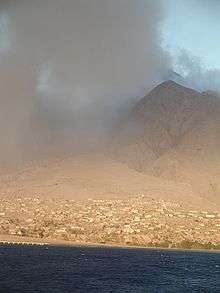
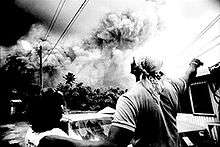
History
Pre-colonial era
Archaeological field work in 2012, in Montserrat's Centre Hills indicated there was an Archaic (pre-Arawak) occupation between 4000 and 2500 BP (2000 - 500 BC).[12] Later coastal sites show the presence of the Saladoid culture (until 550 AD).[13] The native Caribs are believed to have called the island Alliouagana, meaning 'Land of the Prickly Bush'.[14]
Early European period
In November 1493, Christopher Columbus passed Montserrat in his second voyage, after being told that the island was unoccupied due to raids by the Caribs.[15][14]
A number of Irishmen settled in Montserrat in 1632.[16] Most came from nearby St Kitts at the instigation of the island's governor Thomas Warner, with more settlers arriving later from Virginia.[14] The preponderance of Irish in the first wave of European settlers led a leading legal scholar to remark that a "nice question" is whether the original settlers took with them the law of the Kingdom of Ireland insofar as it differed from the law of the Kingdom of England.[17]
The Irish being historical allies of the French, especially in their dislike of the English, invited the French to claim the island in 1666, although no troops were sent by France to maintain control.[16] However the French did attack and briefly occupy the island in the late 1660s;[18] it was captured shortly afterwards by the English and English control of the island was confirmed under the Treaty of Breda the following year.[16] Despite the seizing by force of the island by the English, the island's legal status is that of a "colony acquired by settlement".[16]
A neo-feudal colony developed amongst the so-called "redlegs".[19] The colonists began to transport Sub-Saharan African slaves for labour, as was common to most Caribbean islands.[14] The colonists built an economy based on the production of sugar, rum, arrowroot and sea island cotton, cultivated on large plantations manned by slave labour. By the late 18th century, numerous plantations had been developed on the island.
18th century
There was a brief French attack on Montserrat in 1712.[20] On 17 March 1768, slaves rebelled but failed to achieve freedom.[21][18] The people of Montserrat celebrate St Patrick's Day as a public holiday due to the slave revolt.[22] Festivities held that week commemorate the culture of Montserrat in song, dance, food and traditional costumes.
In 1782, during the American Revolutionary War, as America's first ally, France captured Montserrat in their war of support of the Americans.[22][18] The French, not intent on truly colonising the island, then agreed to return the island to Great Britain under the 1783 Treaty of Paris.[23]
Irish language in Montserrat
The Irish constituted the largest proportion of the white population from the founding of the colony in 1628. Many were indentured servants; others were merchants or plantation owners. The geographer Thomas Jeffrey claimed in The West India Atlas (1780) that the majority of those on Montserrat were either Irish or of Irish descent, "so that the use of the Irish language is preserved on the island, even among the Negroes.”[24]
African slaves and Irish colonists of all classes were in constant contact, with sexual relationships being common and a population of mixed descent appearing as a consequence.[25] The Irish were also prominent in Caribbean commerce, with their merchants importing Irish goods such as beef, pork, butter and herring, and also importing slaves.[26]
There is indirect evidence that the use of the Irish language continued in Montserrat until at least the middle of the nineteenth century. The Kilkenny diarist and Irish scholar Amhlaoibh Ó Súilleabháin noted in 1831 that he had heard that Irish was still spoken in Montserrat by both black and white inhabitants.[27]
in 1852, Henry H. Breen wrote in Notes and Queries: a Medium of Intercommunication for Literary Men, etc. that "The statement that “the Irish language is spoken in the West India Islands, and that in some of them it may be said to be almost vernacular,” is true of the little Island of Montserrat, but has no foundation with respect to the other colonies."[28]
In 1902, The Irish Times quoted the Montreal Family Herald in a description of Montserrat, noting that "the negroes to this day speak the old Irish Gaelic tongue, or English with an Irish brogue. A story is told of a Connaught man who, on arriving at the island, was, to his astonishment, hailed in a vernacular Irish by the black people."[29]
A letter by W. F. Butler in The Atheneum (15 July 1905) quotes an account by a Cork civil servant, C. Cremen, of what he had heard from a retired sailor called John O'Donovan, a fluent Irish speaker:
He frequently told me that in the year 1852, when mate of the brig Kaloolah, he went ashore on the island of Montserrat which was then out of the usual track of shipping. He said he was much surprised to hear the negroes actually talking Irish among themselves, and that he joined in the conversation…[27]
The British phonetician John C. Wells conducted research into speech in Montserrat in 1977–78 (which included also Montserratians resident in London).[30] He found media claims that Irish speech, whether Anglo-Irish or Irish Gaelic, influenced contemporary Montserratian speech were largely exaggerated.[30] He found little in phonology, morphology or syntax that could be attributed to Irish influence, and in Wells' report, only a small number of Irish words in use, one example being minseach [ˈmʲiɲʃəx] which he suggests is the noun goat.[30]
New crops and politics
Britain abolished slavery in Montserrat and its other territories effective August 1834.[31][22][18]
During the nineteenth century, falling sugar prices had an adverse effect on the island's economy, as Brazil and other nations competed in the trade.[32][33]
In 1857, the British philanthropist Joseph Sturge bought a sugar estate to prove it was economically viable to employ paid labour rather than slaves.[14] Numerous members of the Sturge family bought additional land. In 1869 the family established the Montserrat Company Limited and planted Key lime trees, started the commercial production of lime juice, set up a school, and sold parcels of land to the inhabitants of the island. Much of Montserrat came to be owned by smallholders.[34][35]
From 1871 to 1958, Montserrat was administered as part of the federal crown colony of the British Leeward Islands, becoming a province of the short-lived West Indies Federation from 1958 to 1962.[36][14] The first Chief Minister of Montserrat was William Henry Bramble of the Montserrat Labour Party from 1960 to 1970; he worked to promote labour rights and boost tourism to the island, and Montserrat's original airport was named in his honour.[37] However Bramble's son Percival Austin Bramble was critical of the way tourist facilities were being constructed, and he subsequently set up his own party (the Progressive Democratic Party) which went on to win the 1970 Montserratian general election, with Percival Bramble serving as Chief Minister from 1970-78.[38] The period 1978–91 was dominated politically by Chief Minister John Osborne and his People's Liberation Movement; his brief flirtation with possibly declaring independence never materialised.
In 1979, The Beatles producer George Martin opened AIR Studios Montserrat, which resulted in musical artists such as Dire Straits, Paul McCartney, Duran Duran, The Police, Elton John, Jimmy Buffett and The Rolling Stones visiting the island to record albums.[39]
.jpg)
In the early hours of 17 September 1989, Hurricane Hugo passed the island as a Category 4 hurricane, damaging more than 90% of the structures on the island.[14] AIR Studios Montserrat closed, and the tourist economy was virtually wiped out.[40]
Corruption allegations within the PLM party resulted in the collapse of the Osborne government in 1991, with Reuben Meade becoming the new chief minister.[41] As a result, early elections were called.[41]
In 1995, Montserrat was devastated by the catastrophic volcanic eruptions of the Soufrière Hills, which destroyed the capital city of Plymouth, and necessitated the evacuation of a large part of the island. Many Montserratians emigrated abroad, mainly to the United Kingdom, though in recent years some have started returning. The eruptions rendered the entire southern half of the island uninhabitable, and it is currently designated an Exclusion Zone with restricted access.
Criticism of the Montserratian government's response to the disaster led to the resignation of Chief Minister Bertrand Osborne in 1997 after only a year in office, being replaced by David Brandt who remained in office until 2001. Since leaving office Brandt has been the subject of criminal investigation into alleged sex offences with minors.[42]
John Osborne returned as Chief Minister following victory in the 2001 election, being ousted by Lowell Lewis of the Montserrat Democratic Party in 2006. Reuben Meade returned to office in 2009-2014;[43] during his term the post of Chief Minister was replaced with that of Premier.
In the fall of 2017, Montserrat was not hit by Hurricane Irma and sustained only minor damage from Hurricane Maria.[44]
Since November 2019 Easton Taylor-Farrell of the Movement for Change and Prosperity party has been the island's Premier.
Capital Punishment in Montserrat
On 10 May 1991 the Caribbean Territories order came into force, formally abolishing the death penalty for murder on Montserrat.[45]
Politics and government
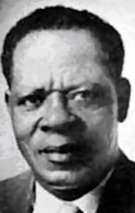
Montserrat is an internally self-governing overseas territory of the United Kingdom.[46] The United Nations Committee on Decolonization includes Montserrat on the United Nations list of Non-Self-Governing Territories. The island's Chief of State is Queen Elizabeth II represented by an appointed Governor. Executive power is exercised by the government, whereas the Premier is the head of government. The Premier is appointed by the Governor from among the members of the Legislative Assembly which consists of nine elected members. The leader of the party with a majority of seats is usually the one who is appointed.[47] Legislative power is vested in both the government and the Legislative Assembly. The Assembly also includes two ex officio members, the attorney general and financial secretary.[47]
Military defence is the responsibility of the United Kingdom so the island has no regular army.
The Judiciary is independent of the executive and the legislature.
Further information: Attorney General of Montserrat
Royal Montserrat Defence Force
The Royal Montserrat Defence Force is the home defence unit of the British Overseas Territory of Montserrat. Raised in 1899, the unit is today a reduced force of about forty volunteer soldiers, primarily concerned with civil Defence and ceremonial duties. The unit has a historical association with the Irish Guards. As a British Overseas Territory (BOT), defence of Montserrat remains the responsibility of the United Kingdom.
Parishes
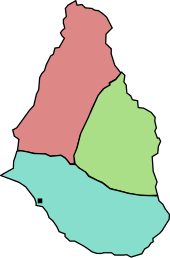
For the purposes of local government, Montserrat is divided into three parishes. Going north to south, they are:
- Saint Peter Parish
- Saint Georges Parish
- Saint Anthony Parish
The locations of settlements on the island have been vastly changed since the volcanic activity began. Only Saint Peter Parish in the northwest of the island is now inhabited, with a population of between 4,000 and 6,000,[48][49] the other two parishes being still too dangerous to inhabit.
Communications
The island is served by landline telephones, fully digitalized, with 3,000 subscribers and by mobile cellular, with an estimated number of 5,000 handsets in use. An estimated 2,860 users have internet access. These are July 2016 estimates. Public radio service is provided by Radio Montserrat. There is a single television broadcaster, PTV.[50] Cable and satellite television service is available.[47]
The UK Postcode for directing mail to Montserrat is MSR followed by four digits according to the destination town, for example, the postcode for Little Bay is MSR1120.[51]
Geography

The island of Montserrat is located approximately 25 miles (39 km) south-west of Antigua, 13m (22 km) south-east of Redonda (a small island owned by Antigua and Barbuda), and 35m (56 km) north-west of the French overseas region of Guadeloupe. Beyond Redonda lies Nevis (part of St Kitts and Nevis), about 30m (49 km) to the north-west. It comprises 104 km2 (40 sq mi) and is gradually increasing owing to the buildup of volcanic deposits on the south-east coast. The island is 16 km (9.9 mi) long and 11 km (6.8 mi) wide and consists of a mountainous interior surrounded by a flatter littoral region, with rock cliffs rising 15 to 30 m (49 to 98 ft) above the sea and a number of smooth bottomed sandy beaches scattered among coves on the western (Caribbean Sea) side of the island. The major mountains are (from north to south) Silver Hill, Katy Hill in the Centre Hills range, the Soufrière Hills and the South Soufrière Hills.[22] The Soufrière Hills volcano is the island's highest point; its pre-1995 height was 915m, however it has now grown due post-eruption due to the creation of a lava dome, with its current height being estimated at 1,050m.[52]
The 2011 estimate by the CIA indicates that 30% of the island's land is classified as agricultural, 20% as arable, 25% as forest and the balance as "other".[47]
Montserrat has a few tiny off-shore islands, such as Little Redonda off its north coast and Pinnacle Rock and Statue Rock off its east.
Volcano and exclusion zone
In July 1995, Montserrat's Soufrière Hills volcano, dormant for centuries, erupted and soon buried the island's capital, Plymouth, in more than 12 metres (39 ft) of mud, destroyed its airport and docking facilities, and rendered the southern part of the island, now termed the exclusion zone, uninhabitable and not safe for travel. The southern part of the island was evacuated and visits are severely restricted.[53] The exclusion zone also includes two sea areas adjacent to the land areas of most volcanic activity.[6]
After the destruction of Plymouth and disruption of the economy, more than half of the population left the island, which also lacked housing. During the late 1990s, additional eruptions occurred. On 25 June 1997, a pyroclastic flow travelled down Mosquito Ghaut. This pyroclastic surge could not be restrained by the ghaut and spilled out of it, killing 19 people who were in the (officially evacuated) Streatham village area. Several others in the area suffered severe burns.
In recognition of the disaster, in 1998, the people of Montserrat were granted full residency rights in the United Kingdom, allowing them to migrate if they chose. British citizenship was granted in 2002.[54]
For a number of years in the early 2000s, the volcano's activity consisted mostly of infrequent ventings of ash into the uninhabited areas in the south. The ash falls occasionally extended into the northern and western parts of the island. In the most recent period of increased activity at the Soufrière Hills volcano, from November 2009 through February 2010, ash vented and there was a vulcanian explosion that sent pyroclastic flows down several sides of the mountain. Travel into parts of the exclusion zone was occasionally allowed, though only by a licence from the Royal Montserrat Police Force.[55] Since 2014 the area has been split into multiple subzones with varying entry and use restrictions, based on volcanic activity: some areas even being (in 2020) open 24 hours and inhabited. The most dangerous zone, which includes the former capital, remains forbidden to casual visitors due to volcanic and other hazards, especially due to the lack of maintenance in destroyed areas. It is legal to visit even this area when accompanied by a government-authorized guide. [56][57][58]
The northern part of Montserrat has largely been unaffected by volcanic activity, and remains lush and green. In February 2005, The Princess Royal officially opened what is now called the John A. Osborne Airport in the north. Since 2011, it handles several flights daily operated by Fly Montserrat Airways. Docking facilities are in place at Little Bay, where the new capital town is being constructed; the new government centre is at Brades, a short distance away.
Wildlife
Montserrat, like many isolated islands, is home to rare, endemic plant and animal species. Work undertaken by the Montserrat National Trust in collaboration with the Royal Botanic Gardens, Kew has centred on the conservation of pribby (Rondeletia buxifolia) in the Centre Hills region. Until 2006, this species was known only from one book about the vegetation of Montserrat.[59] In 2006, conservationists also rescued several plants of the endangered Montserrat orchid (Epidendrum montserratense) from dead trees on the island and installed them in the security of the island's botanic garden.
Montserrat is also home to the critically endangered giant ditch frog (Leptodactylus fallax), known locally as the mountain chicken, found only in Montserrat and Dominica. The species has undergone catastrophic declines due to the amphibian disease Chytridiomycosis and the volcanic eruption in 1997. Experts from Durrell Wildlife Conservation Trust have been working with the Montserrat Department of Environment to conserve the frog in-situ in a project called "Saving the Mountain Chicken",[60] and an ex-situ captive breeding population has been set up in partnership with Durrell Wildlife Conservation Trust, Zoological Society of London, North of England Zoological Society, Parken Zoo and the Governments of Montserrat and Dominica. Releases from this programme have already taken place in a hope to increase the numbers of the frog and reduce extinction risk from Chytridiomycosis.
The national bird is the endemic Montserrat oriole (Icterus oberi).[61] The IUCN Red List classifies it as Vulnerable, having previously listed it as Critically Endangered.[62] Captive populations are held in several zoos in the UK including: Chester Zoo, London Zoo, Jersey Zoo and Edinburgh Zoo.
The Montserrat galliwasp (Diploglossus montisserrati), a type of lizard, is endemic to Montserrat and is listed on the IUCN Red List as Critically Endangered.[63][64] A species action plan has been developed for this species.[65]
In 2005, a biodiversity assessment for the Centre Hills was conducted. To support the work of local conservationists, a team of international partners, including Durrell Wildlife Conservation Trust, Royal Botanic Gardens, Kew, Royal Society for the Protection of Birds and Montana State University, carried out extensive surveys and collected biological data.[66] Researchers from Montana State University found that the invertebrate fauna was particularly rich on the island. The report found that the number of invertebrate species known to occur in Montserrat is 1,241. The number of known beetle species is 718 species from 63 families. It is estimated that 120 invertebrates are endemic to Montserrat.[66]
Montserrat is known for its coral reefs and its caves along the shore. These caves house many species of bats, and efforts are underway to monitor and protect the ten species of bats from extinction.[67][68]
The Montserrat Tarantula (Cyrtopholis femoralis) is the only species of tarantula native to the island. It was first bred in captivity at the Chester Zoo in August 2016.[69]
Economy
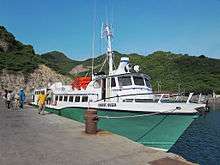
Montserrat's economy was devastated by the 1995 eruption and its aftermath;[22] currently the island's operating budget is largely supplied by the British government and administered through the Department for International Development (DFID) amounting to approximately £25 million per year. Additional amounts are secured through income and property taxes, licence and other fees as well as customs duties levied on imported goods.
The limited economy of Montserrat, with a population under 5,000, many living in shelters and shacks without utilities, only consumes 2.5 MW of electric power,[70] produced by five diesel generators.[71] Two exploratory geothermal wells have found good resources and the pad for a third geothermal well was prepared in 2016.[72] Together the geothermal wells are expected to produce more power than the island requires.[73] A 250 kW solar PV station was commissioned in 2019, with plans for another 750 kW.[70]
A report published by the CIA indicated that the value of exports totaled the equivalent of US$5.7 million (2017 est.), consisting primarily of electronic components, plastic bags, apparel, hot peppers, limes, live plants and cattle. The value of imports totaled US$31.02 million (2016 est.), consisting primarily of machinery and transportation equipment, foodstuffs, manufactured goods, fuels and lubricants.[47]
From 1979 to 1989, Montserrat was home to a branch of George Martin's AIR Studios, making the island popular with musicians who often went there to record while taking advantage of the island's climate and beautiful surroundings; the studio closed as a result of Hurricane Hugo.[74]
Transportation
.jpg)
Air
John A. Osborne Airport is the only airport on the island. Scheduled service to Antigua is provided by FlyMontserrat[75] and ABM Air.[76] Charter flights are also available to the surrounding islands.
Sea
Ferry service to the island is provided by the Jaden Sun Ferry. It runs from Heritage Quay in St. John's, Antigua and Barbuda to Little Bay on Montserrat. The ride is about an hour and a half and operates five days a week.[77]
Demographics
The island had a population of 5,879 (according to a 2008 estimate). An estimated 8,000 refugees left the island (primarily to the UK) following the resumption of volcanic activity in July 1995; the population was 13,000 in 1994. The 2011 Montserrat census indicated a population of 4,922.[78] In early 2016, the estimated population had reached nearly 5,000 primarily due to immigration from other islands.[7]
Age structure (2003 estimates):
- 0–14 years: 23.4% (male 1,062; female 1,041)
- 15–64 years: 65.3% (male 2,805; female 3,066)
- 65 years and over: 11.3% (male 537; female 484)
The median age of the population was 28.1 as of 2002 and the sex ratio was 0.96 males/female as of 2000.
The population growth rate is 6.9% (2008 est.), with a birth rate of 17.57 births/1,000 population, death rate of 7.34 deaths/1,000 population (2003 est.), and net migration rate of 195.35/1,000 population (2000 est.) There is an infant mortality rate of 7.77 deaths/1,000 live births (2003 est.). The life expectancy at birth is 78.36 years: 76.24 for males and 80.59 for females (2003 est.). The total fertility rate is 1.8 children born/woman (2003 est.).
According to a United Nations estimate, the population as of April 2018 was 5,197 (for a density of 52 per square kilometer or 135 people per square mile), with just over 90% living in non-urban areas. [79] In 2001, the CIA estimated the primary religion as Protestant (67.1%, including Anglican 21.8%, Methodist 17%, Pentecostal 14.1%, Seventh Day Adventist 10.5%, and Church of God 3.7%), with Roman Catholics constituting 11.6%, Rastafarian 1.4%, other 6.5%, none 2.6%, unspecified 10.8%.[47]
Ethnic groups
Residents of Montserrat are known as Montserratians. The population is predominantly, but not exclusively, of mixed African-Irish descent.[80] It is not known with certainty how many African slaves and indentured Irish labourers were brought to the West Indies, though according to one estimate some 60,000 Irish were "Barbadosed" by Oliver Cromwell,[81] some of whom would have arrived in Montserrat.
Data published by the Central Intelligence Agency indicates the ethnic group mix as follows (2011 est.):[47]
- African/black 88.4%
- Mixed 3.7%
- Hispanic/Spanish 3%
- non-Hispanic Caucasian/white 2.7%
- East Indian/Indian 1.5%
- Other 0.7%
Education
Education in Montserrat is compulsory for children between the ages of 5 and 14, and free up to the age of 17. The only secondary school (pre-16 years of age) on the island is the Montserrat Secondary School (MSS) in Salem.[82] Montserrat Community College (MCC) is a community college (post-16 and tertiary educational institution) in Salem.[83] The University of the West Indies maintains its Montserrat Open Campus.[84] University of Science, Arts and Technology is a private medical school in Olveston.[85]
Culture
.jpg)
In 1979, George Martin, an English record producer, built a recording studio on the island called AIR Studios Montserrat. For more than a decade, AIR Montserrat played host to recording sessions by many well known rock musicians, including Dire Straits, Elton John, Michael Jackson and The Rolling Stones.[74] In 1989, Hurricane Hugo destroyed the studios.
After the volcanic eruptions of 1995 through 1997, and until his death in 2016, George Martin raised funds to help the victims and families on the island. The first event was a star-studded event at London's Royal Albert Hall in September 1997 (Music for Montserrat) featuring many artists who had previously recorded on the island including Paul McCartney, Mark Knopfler, Elton John, Sting, Phil Collins, Eric Clapton and Midge Ure. All the proceeds from the show went towards short-term relief for the islanders.[74]
Martin's second major initiative was to release five hundred limited edition lithographs of his score for the Beatles song "Yesterday". Complete with mistakes and tea stains, the lithographs are numbered and signed by Paul McCartney and Martin. The lithograph sale raised more than US$1.4 million which helped fund the building of a new cultural and community centre for Montserrat and provided a much needed focal point to help the re-generation of the island.[74]
Many albums of note were recorded at AIR Studios, including Dire Straits' Brothers in Arms; Duran Duran's Seven and the Ragged Tiger, the Police's Synchronicity and Ghost in the Machine (videos for "Every Little Thing She Does Is Magic" and "Spirits in the Material World" were actually filmed in Montserrat), and Jimmy Buffett's Volcano (named for Soufrière Hills). After sustaining severe damage from Hurricane Hugo in 1989, the studio is now a ruin.[74] Ian Anderson (of Jethro Tull) recorded the song "Montserrat" on The Secret Language of Birds in tribute to the volcanic difficulties and feeling among residents of being abandoned by the UK government.
Media
Montserrat has one national radio station, ZJB. The station offers a wide selection of music and news within the island and also on the internet for Montserratians living overseas.
Notable shows include the Morning Show with Basil Chambers and Rose Willock's Cultural Show.
Cuisine
Montserrat's national dish is goat water, a thick goat meat stew served with crusty bread rolls.[7] Montserrat cuisine resembles the general British and Caribbean cuisines, as it is situated in the Caribbean zone and it is a British territory. The cuisine includes a wide range of light meats, like fish, seafood and chicken, which are mostly grilled or roasted. Being a fusion of numerous cultures, such as Spanish, French, African, Indian and Amerindian, the Caribbean cuisine is unique and complex. More sophisticated meals include the Montserrat jerk shrimp, with rum, cinnamon bananas and cranberry. In other more rural areas, people prefer to eat homemade food, like the traditional mahi mahi and local breads.
Sport
Yachting
Montserrat is home to the Montserrat Yachting Association.[86]
Athletics
Montserrat has competed in every Commonwealth Games since 1994.[87]
Basketball
Basketball is growing in popularity in Montserrat with the country now setting up their own basketball league.[88][89] The league contains six teams, which are the Look-Out Shooters, Davy Hill Ras Valley, Cudjoe Head Renegades, St. Peters Hilltop, Salem Jammers and MSS School Warriors.[90] They have also built a new 800 seater complex which cost $1.5 million.
Cricket
In common with many Caribbean islands, cricket is a very popular sport in Montserrat. Players from Montserrat are eligible to play for the West Indies cricket team. Jim Allen was the first to play for the West Indies and he represented the World Series Cricket West Indians, although, with a very small population, no other player from Montserrat had gone on to represent the West Indies until Lionel Baker made his One Day International debut against Pakistan in November 2008.[91]
The Montserrat cricket team forms a part of the Leeward Islands cricket team in regional domestic cricket, however it plays as a separate entity in minor regional matches,[92] as well having previously played Twenty20 cricket in the Stanford 20/20.[93] Two grounds on the island have held first-class matches for the Leeward Islands, the first and most historic was Sturge Park in Plymouth, which had been in use since the 1920s. This was destroyed in 1997 by the volcanic eruption. A new ground, the Salem Oval, was constructed and opened in 2000. This has also held first-class cricket. A second ground has been constructed at Little Bay.[94]
Football
Montserrat has its own FIFA affiliated football team, and has competed in the World Cup qualifiers five times but failed to advance to the finals from 2002 to 2018. A field for the team was built near the airport by FIFA. In 2002, the team competed in a friendly match with the second-lowest-ranked team in FIFA at that time, Bhutan, in The Other Final, the same day as the final of the 2002 World Cup. Bhutan won 4–0. Montserrat has failed to qualify for any FIFA World Cup. They have also failed to ever qualify for the Gold Cup and Caribbean Cup. The current national team relies mostly on the diaspora resident in England and in the last WCQ against Curaçao nearly all the squad members played and lived in England.
Settlements
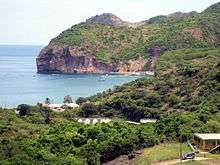
Settlements within the exclusion zone are no longer habitable. See also List of settlements abandoned after the 1997 Soufrière Hills eruption.
Settlements in the safe zone
- Baker Hill
- Banks
- Barzeys
- Blakes
- Brades[lower-alpha 2]
- Carr's Bay
- Cavalla Hill
- Cheap End
- Cudjoe Head
- Davy Hill
- Dick Hill
- Drummonds
- Flemmings
- Fogarty
- Frith
- Garibaldi Hill
- Gerald's[lower-alpha 5]
- Hope
- Jack Boy Hill
- Judy Piece
- Katy Hill
- Lawyers Mountain
- Little Bay[lower-alpha 3]
- Lookout
- Manjack
- Mongo Hill
- New Windward Estate
- Nixons
- Old Towne
- Olveston
- Salem
- Shinlands
- St. John's
- St. Peter's
- Sweeney's
- Woodlands
Abandoned settlements in the exclusion zone
Settlements in italic have been destroyed by pyroclastic flows since the 1997 eruption. Others have been evacuated or destroyed since 1995.
- Amersham
- Beech Hill
- Bethel
- Bramble
- Bransby
- Bugby Hole
- Cork Hill
- Dagenham
- Delvins
- Dyers
- Elberton
- Farm
- Fairfield
- Fairy Walk
- Farrells
- Farells Yard
- Ffryes
- Fox's Bay
- Gages
- Gallways Estate
- Gringoes
- Gun Hill
- Happy Hill
- Harris
- Harris Lookout
- Hermitage
- Hodge's Hill
- Jubilee
- Kinsale
- Lees
- Locust Valley
- Long Ground
- Molyneux
- Morris
- Parsons
- Plymouth[lower-alpha 1]
- Richmond
- Richmond Hill
- Roche's Yard
- Robuscus Mt
- Shooter's Hill
- Soufrière
- Spanish Point
- St. George's Hill
- St. Patrick's
- Streatham
- Trants
- Trials
- Tuitts
- Victoria
- Webbs
- Weekes
- White's
- Windy Hill
Notable Montserratians
- Jim Allen, former cricketer who represented the World Series Cricket West Indians
- Jennette Arnold, the first Montserratian elected as a Member of the London Assembly, who served four terms as Chair of the Assembly
- Lionel Baker, the first Montserratian to represent the West Indies in international cricket
- Alphonsus "Arrow" Cassell, musician known for his soca song "Hot Hot Hot"
- Vladimir Farrell, association footballer
- Howard A. Fergus, author, poet and three time acting governor of Montserrat
- Patricia Griffin, pioneer nurse and volunteer social worker, honored on a 2006 series of stamps recognizing notable citizens[96]
- George Irish, writer, human rights activist
- Helen Joseph, Miss Montserrat 1964 and Top 16 in Miss World 1964
- E. A. Markham, poet and author
- Dean Mason, association footballer
- Shane Ryan, writer, human rights activist
- M. P. Shiel, writer
- Lyle Taylor, association footballer
- Maizie Williams, member of pop group Boney M
- Angela Yee, member of Power 105.1's morning show, the Breakfast Club
See also
- Bibliography of Montserrat
- Index of Montserrat-related articles
- Outline of Montserrat
Notes
- Abandoned in 1997, following a volcanic eruption, although it is still the de jure capital.
- Government buildings are now located in Brades, making it the de facto capital.
- New seaport and town, intended to be the future capital.
- Minister of State in the Foreign and Commonwealth Office with responsibility for the British Overseas Territories.
- Includes the new airport in the north of the island.
References
- https://statistics.gov.ms/wp-content/uploads/2019/08/FINAL-REPORT-KEY-FINDINGS-CENSUS-LABOUR-FORCE-SURVEY-2018-.pdf
- "UN Data". 2014. Retrieved 8 January 2017.
- Montserrat. CIA World Factbook. Central Intelligence Agency. 19 September 2006. Retrieved 1 October 2006.
- "The Caribbean Irish: the other Emerald Isle". The Irish Times. 16 April 2016. Retrieved 9 January 2018.
- "► VIDEO: Montserrat, the Emerald Isle of the Caribbean". www.irishtimes.com. Retrieved 9 January 2018.
- "Montserrat Volcano Observatory". Mvo.ms. Archived from the original on 2 October 2006. Retrieved 2 October 2006.
- Schuessler, Ryan (14 February 2016). "20 years after Montserrat volcano eruption, many still in shelter housing". Al Jazeera America. Retrieved 23 November 2016.
Montserrat's population has grown to nearly 5,000 people since the eruption — mostly due to an influx of immigrants from other Caribbean nations.
- Bachelor, Blane (20 February 2014). "Montserrat: a modern-day Pompeii in the Caribbean". Fox News.
- Pilley, Kevin (29 February 2016). "Bar/fly: Caribbean island of Montserrat". The New Zealand Herald.
- Handy, Gemma (16 August 2015). "Montserrat: Living with a volcano". BBC News. Retrieved 8 July 2017.
- Minahan, James (1 December 2009). The Complete Guide to National Symbols and Emblems: Volume 2. Greenwood Press. p. 724. ISBN 978-0-313-34500-5.
- Cherry, John F.; Ryzewski, Krysta; Leppard, Thomas P. & Bocancea, Emanuela (September 2012). "The earliest phase of settlement in the eastern Caribbean: new evidence from Montserrat". Antiquity. 86 (333). Retrieved 25 August 2013.
- Reid, Basil A. (2009). Myths and Realities of Caribbean History. University of Alabama Press. p. 21. ISBN 0817355340.
However, archaeological investigations of the very large site of Trants in Montserrat ... [suggest that Trants was] one of the largest Saladoid sites in the Caribbean.
- "Encyclopaedia Britannica - Monts/errat". Retrieved 28 June 2019.
- Bergreen, Laurence (2011). Columbus: The Four Voyages. Viking. p. 140. ISBN 9780670023011.
At daybreak on November 10, Columbus and his fleet departed from Guadeloupe, sailing northwest along the coast to the island of Montserrat. The handful of Indians aboard his ship explained that the island had been ravaged by the Caribs, who had 'eaten all its inhabitants'.
- Roberts-Wray, Kenneth (1966). Commonwealth and Colonial Law. London: Stevens. p. 855.
- Roberts-Wray, Kenneth (1966). Commonwealth and Colonial Law. London: Stevens. p. 856.
- "Brown Archaeology- Montserrat". Retrieved 28 June 2019.
- Akenson, Donald H. (1997). "Ireland's neo-Feudal Empire, 1630–1650". If the Irish ran the world: Montserrat, 1630–1730. McGill-Queen's University Press. pp. 12–57, 273. ISBN 978-0-7735-1686-1.
- "Brown Archeology- Montserrat". Retrieved 28 June 2019.
- Fergus, Howard A. (1996). Gallery Montserrat: some prominent people in our history. Canoe Press, University of West Indies. p. 83. ISBN 976-8125-25-X.
- "Encyclopaedia Britannica - Montserrat". Retrieved 28 June 2019.
- O'Shaughnessy, A. J. (2006). "Caribbean". In Boatner, III, M. M. (ed.). Landmarks of the American Revolution: Library of Military History (2nd ed.). Detroit, MI: Charles Scribner's Sons. p. 33. ISBN 9780684314730 – via Gale Virtual Reference.
- Cited in: Truxes, Thomas M. (2004). Irish-American Trade, 1660-1783. Cambridge University Press. p. 100. See also: The late Thomas Jefferys, Geographer to the King (1780). The West India Atlas or, A Compendious Description of the West-Indies. Fleet Street, London: Robert Sayer and John Bennett.
- Rodgers, Nini (November 2007). "The Irish in the Caribbean 1641-1837: An Overview". Irish Migration Studies in Latin America. 5 (3): 145–156.
- McGarrity, Maria (2008). Washed by the Gulf Stream: The Historic and Geographic Relation of Irish and Caribbean Literature. Associated University Presses. pp. 33–34. ISBN 9780874130287.
- De Bhaldraithe, Tomás, ed. (1979). "Entry 2700, 1 Aibreán 1831 [1 April 1831]". Cín Lae Amhlaoibh (in Irish). Baile Átha Cliath: An Clóchomhar Tta. p. 84.
Is clos dom gurb í an teanga Ghaeilge is teanga mháthartha i Monserrat san India Thiar ó aimsir Olibher Cromaill, noch do dhíbir cuid de chlanna Gael ó Éirinn gusan Oileán sin Montserrat. Labhartar an Ghaeilge ann go coiteann le daoine dubha agus bána. [I heard that the Irish language is the mother tongue in Montserrat in the West Indies since the time of Oliver Cromwell, who banished some Gaelic Irish families there. Irish speaking is common among both blacks and whites.]
- "Notes and Queries: A Medium of Inter-Communication for Literary Men, Artists, Antiquaries, Genealogists, Etc". Bell. 15 July 1852 – via Google Books.
- The Irish Times (Monday, 8 September 1902), page 5.
- Wells, John C. (1980). "The brogue that isn't". Journal of the International Phonetic Association. 10: 74–79. doi:10.1017/s0025100300002115. Retrieved 29 April 2017.
- "Slavery Abolition Act 1833; Section XII". 28 August 1833. Retrieved 23 May 2016.
- Beckles, Hilary McD (1998). "Caribbean Region: English Colonies". In Finkelman, Paul; Miller, Joseph Calder (eds.). Macmillan Encyclopedia of World Slavery. 1. Simon & Schuster Macmillan. pp. 154–159. ISBN 9780028647807.
- Finkleman, Paul; Calder Miller, Joseph, eds. (1998). "Plantations: Brazil". Macmillan Encyclopedia of World Slavery. Macmillan Reference USA – via GALE World History in Context.
- "The Montserrat Connection". Sturgefamily.com. Archived from the original on 4 January 2017. Retrieved 8 July 2017.
- "Montserrat". Commonwealth Secretariat. Archived from the original on 8 July 2011. Retrieved 30 January 2007.
- Hendry, Ian; Dickson, Susan (2011). British Overseas Territories Law. Oxford: Hart Publishing. p. 325. ISBN 9781849460194.
- Gallery Montserrat: some prominent people in our history By Howard A. Fergus. Publisher: Canoe Press University of the West Indies. ISBN 978-976-8125-25-5 / ISBN 976-8125-25-X
- Robert J Alexander & Eldon M Parker (2004) A History of Organized Labor in the English-speaking West Indies, Greenwood Publishing Group, p144
- "Sir George Martin CBE (1926 – 2016)". George Martin Music. 2017.
- National Research Council (1994). Hurricane Hugo, Puerto Rico, the U.S. Virgin Islands, and Charleston, South Carolina, September 17-22, 1989. Washington, D.C.: The National Academies Press. doi:10.17226/1993. ISBN 978-0-309-04475-2.
- South America, Central America and the Caribbean 2002, Psychology Press, p565
- "Attorney-at-Law David S. Brandt Has Been Remanded into Custody at Her Majesty's Prison on Montserrat". www.mnialive.com.
- Radio Jamaica, New MCPR Gov’t in Montserrat , 9 September 2009, retrieved 10 September 2009.
- "Update on Caribbean IP Offices Following Hurricanes Irma and Maria". Inta.org. Retrieved 28 April 2019.
- "The Caribbean Territories (Abolition of Death Penalty for Murder) Order 1991". www.legislation.gov.uk. Retrieved 15 March 2020.
- "Montserrat Government Profile 2018". Indexmundi.com. Retrieved 28 April 2019.
- "Central America :: Montserrat — The World Factbook - Central Intelligence Agency". Cia.gov. Retrieved 28 April 2019.
- Kowalski, Jeff (11 September 2009). "Central America and Caribbean: Monserrat". Retrieved 26 October 2009.
- Wittebol, Hans. "The Parishes of Montserrat". Statoids.com. Retrieved 26 October 2009.
- "People's TV". Raffa. Archived from the original on 21 September 2014.
- "Postcode guide pamphlet" (PDF). Gov.ms. Retrieved 1 August 2018.
- "CIA World Factbook - Montserrat". Retrieved 28 June 2019.
- Leonard, T. M. (2005). Encyclopedia of the Developing World. Routledge. p. 1083. ISBN 978-1-57958-388-0.
- "Types of British nationality: British overseas territories citizen". British Government. Retrieved 8 July 2017.
- "Montserrat (British Overseas Territory) travel advice". Travel & living abroad. Foreign and Commonwealth Office. 19 December 2012. Retrieved 31 December 2012.
- https://wikitravel.org/en/Soufriere_Hills_Volcano_Exclusion_Zone
- http://mvoms.org/pub/Hazard_Level_System/HLS-20140801.pdf
- http://www.visitmontserrat.com/facts/#4
- Johnson, Nick (22 October 2010). "The 'Montserrat pribby' (part one)". kew.org. Archived from the original on 22 February 2014. Retrieved 30 November 2010.
- "Saving the Mountain Chicken:A Long-Term Recovery Strategy for the Critically Endangered mountain chicken 2014-2034" (PDF). Amphibians.org.
- "Montserrat oriole photo - Icterus oberi - G55454". Arkive.org. Archived from the original on 30 November 2016. Retrieved 8 July 2017.
- "Icterus oberi (Montserrat Oriole)". IUCN Red List of Threatened Species. Retrieved 8 July 2017.
- "Diploglossus montisserrati (Montserrat Galliwasp)". IUCN Red List of Threatened Species. Retrieved 8 July 2017.
- "Montserrat galliwasp videos, photos and facts - Diploglossus montisserrati". Arkive.org. Archived from the original on 3 February 2017. Retrieved 8 July 2017.
- Corry, E.; et al. (2010). A Species Action Plan for the Montserrat galliwasp: Diploglossus montisserrati (PDF). Department of Environment, Montserrat. ISBN 978-0-9559034-5-8. Archived from the original (PDF) on 9 February 2017.
- Young, Richard P., ed. (2008). "A biodiversity assessment of the Centre Hills, Montserrat" (PDF). Durrell Wildlife Conservation Trust. Durrell Conservation Monograph No. 1.
- "Bats". Sustainable Ecosystems Institute. Archived from the original on 6 October 2014.
- Pedersen, Scott C.; Kwiecinski, Gary G.; Larsen, Peter A.; Morton, Matthew N.; Adams, Rick A.; Genoways, Hugh H. & Swier, Vicki J. (1 January 2009). "Bats of Montserrat: Population Fluctuation and Response to Hurricanes and Volcanoes, 1978–2005". ResearchGate. Retrieved 31 July 2011.
- "Montserrat tarantulas hatch in 'world first'". Chester Zoo. 12 August 2016.
- Roach, Bennette. "Is this end of Geothermal Energy development?". Retrieved 31 January 2020.
- "Energy Snapshot: Montserrat" (PDF). NREL. September 2015.
- Richter, Alexander (2 September 2016). "Well pad ready for drilling of third geothermal well in Montserrat". Think Geoenergy.
- Handy, Gemma (8 November 2015). "Does Montserrat's volcano hold the key to its future?". BBC News Online.
- "AIR Montserrat". AIR Studios. Archived from the original on 18 October 2014. Retrieved 5 January 2013.
- "FlyMontserrat flight schedule". Retrieved on 16 May 2019
- "ABM route map". Retrieved on 16 May 2019.
- "Jaden Sun Ferry Schedule". Retrieved on 16 May 2019
- "Census 2011 At a Glance" (PDF). Government of Montserrat. Statistics Department, Montserrat. 2011. Retrieved 23 November 2016.
- "Montserrat Population (2019) - Worldometers". Worldometers.info. Retrieved 28 April 2019.
- McGinn, Brian. "How Irish is Montserrat? (The Black Irish)". RootsWeb.com.
- "Barbadosed: Africans and Irish in Barbados". Tangled Roots. Archived from the original on 8 December 2014.
- "Territories and Non-Independent Countries". 2001 Findings on the Worst Forms of Child Labor. Bureau of International Labor Affairs, US Department of Labor. 2002. Archived from the original on 28 March 2005.
- Home page. Montserrat Community College. Retrieved on 24 November 2017. "Salem, Montserrat W. I."
- "The Open Campus in Montserrat." University of the West Indies Open Campus. Retrieved on 24 November 2017.
- "Contact USAT." University of Science, Arts and Technology. Retrieved on 24 November 2017. "Main Campus: South Mayfield Estate Drive, Olveston, Montserrat"
- AlMirSoft. "Yacht registration, training and certification of yachtsmen". Montserrat Yachting Association. Retrieved 23 September 2016.
- "Commonwealth Games Countries: Montserrat". Commonwealth Games Federation. Archived from the original on 26 June 2014. Retrieved 24 July 2014.
- "Montserrat Volcanos". Montserrat Amateur Basketball Association. Retrieved 8 July 2017.
- "Village basketball league makes a comeback". The Montserrat Reporter. 11 July 2012. Retrieved 8 July 2017.
- Cassell, Warren (18 July 2015). "Montserrat 2015 basketball Championship game Salem Jammers vs. Lookout Shooters". YouTube. Retrieved 8 July 2017.
- "Late Show Wins It For Pakistan In Abu Dhabi". CricketWorld.com. 12 November 2008.
- "Other Matches played by Montserrat". CricketArchive. Retrieved 12 October 2012.
- "Twenty20 Matches played by Montserrat". CricketArchive. Retrieved 7 October 2012.
- "Island of Montserrat". Foreign and Commonwealth Office. Archived from the original on 1 July 2012. Retrieved 13 October 2012.
- "Little Bay Development". Projects.dfid.gov.uk. 2010. Archived from the original on 25 April 2013.
- Mott, Nicola (17 February 2006). "Stamp of approval!". Lancashire Telegraph. Blackburn, Lancashire, England. Archived from the original on 30 November 2016. Retrieved 4 December 2016.
External links
Government
- Government of Montserrat
- Montserrat National Trust
- Premier of Montserrat
General information
- "Montserrat". The World Factbook. Central Intelligence Agency.
- Montserrat from UCB Libraries GovPubs.
- Montserrat at Curlie
- Montserrat Webdirectory
- Story of the black Irish in Montserrat

News media
Travel
Health reports
- Toxicity of volcanic ash from Montserrat by RT Cullen, AD Jones, BG Miller, CL Tran, JMG Davis, K Donaldson, M Wilson, V Stone, and A Morgan. Institute of Occupational Medicine Research Report TM/02/01.
- A Health Survey of Workers on the Island of Montserrat by HA Cowie, MK Graham, A Searl, BG Miller, PA Hutchison, C Swales, S Dempsey, and M Russell. Institute of Occupational Medicine Research Report TM/02/02.
- A Health Survey of Montserratians Relocated to the UK by HA Cowie, A Searl, PJ Ritchie, MK Graham, PA Hutchison, and A Pilkington. Institute of Occupational Medicine Research Report TM/01/07.
Others
- Montserrat Volcano Observatory
- Official release archive
- Antigua, Montserrat and Virgin Islands Gazette at the Digital Library of the Caribbean.

Countries.png)